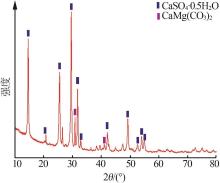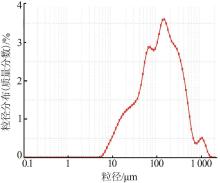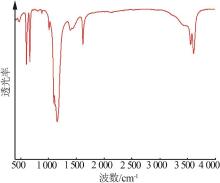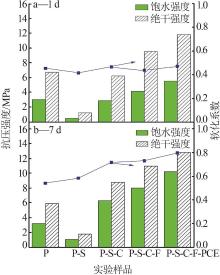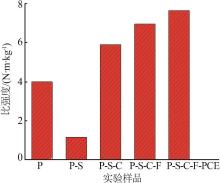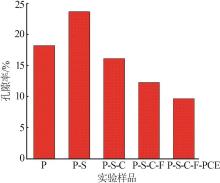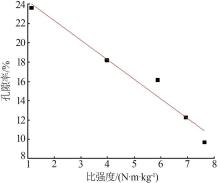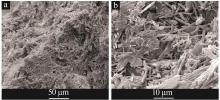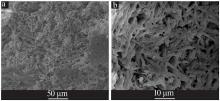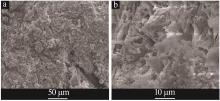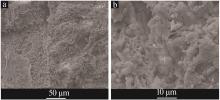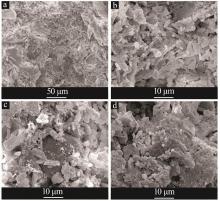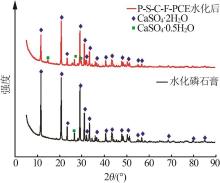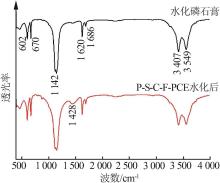Inorganic Chemicals Industry ›› 2022, Vol. 54 ›› Issue (9): 136-142.doi: 10.19964/j.issn.1006-4990.2021-0723
• Environment·Health·Safety • Previous Articles Next Articles
Study on performance optimization and mechanism of phosphogypsum based composite cementitious materials
ZHANG Taiyue1( ),XIE Fan2,GUO Junyuan3
),XIE Fan2,GUO Junyuan3
- 1. Architectural Engineering Institute,Jiangsu College of Engineering and Technology,Nantong 226000,China
2. Shanghai Modern Architectural Design Group Engineering Construction Consulting Co.,Ltd
3. Key Lab of Advanced Civil Engineering Materials(Tongji University),Ministry of Education
-
Received:2022-01-05Online:2022-09-10Published:2022-09-22
CLC Number:
Cite this article
ZHANG Taiyue,XIE Fan,GUO Junyuan. Study on performance optimization and mechanism of phosphogypsum based composite cementitious materials[J]. Inorganic Chemicals Industry, 2022, 54(9): 136-142.
share this article
| [1] | 李光明,李霞,贾磊,等.国内外磷石膏处理和处置概况[J].无机盐工业,2012,44(10):11-13. |
| LI Guangming, LI Xia, JIA Lei, et al.General situation of treatment and disposal of phosphogypsum[J].Inorganic Chemicals Industry,2012,44(10):11-13. | |
| [2] | TAYIBI H, CHOURA M, LÓPEZ F A, et al.Environmental impact and management of phosphogypsum[J].Journal of Environmental Management,2009,90(8):2377-2386. |
| [3] | 郑绍聪,汪帆,朱丽苹,等.磷渣粉改性磷石膏实验研究[J].无机盐工业,2020,52(1):73-75. |
| ZHENG Shaocong, WANG Fan, ZHU Liping, et al.Experimental study on influence of phosphogypsum with modified phosphorus slag powder[J].Inorganic Chemicals Industry,2020,52(1):73-75. | |
| [4] | LIU Shuhua, WANG Lu, YU Baoying.Effect of modified phosphogypsum on the hydration properties of the phosphogypsum-based supersulfated cement[J].Construction and Building Materials,2019,214:9-16. |
| [5] | 杨兆娟,向兰.磷石膏综合利用现状评述[J].无机盐工业,2007,39(1):8-10. |
| YANG Zhaojuan, XIANG Lan.Review of comprehensive utilization of phosphogypsum[J].Inorganic Chemicals Industry,2007,39(1):8-10. | |
| [6] | 袁书成,刘香玲,梁危,等.磷石膏填充墙研究现状与应用进展[J].无机盐工业,2021,53(4):8-13. |
| YUAN Shucheng, LIU Xiangling, LIANG Wei, et al.Research status and application progress of phosphogypsum infilled walls[J].Inorganic Chemicals Industry,2021,53(4):8-13. | |
| [7] | 彭家惠,彭志辉,张建新,等.磷石膏中可溶磷形态、分布及其对性能影响机制的研究[J].硅酸盐学报,2000,28(4):309-313. |
| PENG Jiahui, PENG Zhihui, ZHANG Jianxin, et al.Study on the form and distribution of water⁃soluble P2O5 in phosphogypsum and effective mechanism of properties[J].Journal of the Chinese Ceramic Society,2000,28(4):309-313. | |
| [8] | MIN Chendi, LI Xibing, HE Suya, et al.Effect of mixing time on the properties of phosphogypsum⁃based cemented backfill[J].Construction and Building Materials,2019,210:564-573. |
| [9] |
ROSALES J, PÉREZ S M, CABRERA M, et al.Treated phosphogypsum as an alternative set regulator and mineral addition in cement production[J].Journal of Cleaner Production,2020,244.Doi:10.1016/j.jclepro.2019.118752.
doi: 10.1016/j.jclepro.2019.118752. |
| [10] | CHEN Qiusong, ZHANG Qinli, QI Chongchong, et al.Recycling phosphogypsum and construction demolition waste for cemented paste backfill and its environmental impact[J].Journal of Cleaner Production,2018,186:418-429. |
| [11] |
WANG Qiang, CUI Yong, XUE Junfeng.Study on the improvement of the waterproof and mechanical properties of hemihydrate phosphogypsum⁃based foam insulation materials[J].Construction and Building Materials,2020,230.Doi:10.1016/j.conbuildmat. 2019.117014.
doi: 10.1016/j.conbuildmat. 2019.117014. |
| [12] |
MA Baoguo, JIN Zihao, SU Ying, et al.Utilization of hemihydrate phosphogypsum for the preparation of porous sound absorbing material[J].Construction and Building Materials,2020,234.Doi:10.1016/j.conbuildmat.2019.117346.
doi: 10.1016/j.conbuildmat.2019.117346. |
| [13] | 罗双,付汝宾,孔德文,等.掺合料对磷石膏基复合胶凝材料耐水性及强度的影响综述[J].无机盐工业,2020,52(11):6-11. |
| LUO Shuang, FU Rubin, KONG Dewen, et al.Summary on effects of admixtures on water resistance and strength of phosphogypsum⁃based composite cementitious materials[J].Inorganic Chemicals Industry,2020,52(11):6-11. | |
| [14] | 何玉鑫,万建东,唐永波,等.磷石膏复合材料的研究进展[J].材料导报,2013,27(S1):306-308,325. |
| HE Yuxin, WAN Jiandong, TANG Yongbo, et al.Research progress of phosphogypsum composite materials[J].Materials Review,2013,27(S1):306-308,325. | |
| [15] | JIANG Guanzhao, WU Aixiang, WANG Yiming, et al.Low cost and high efficiency utilization of hemihydrate phosphogypsum:Used as binder to prepare filling material[J].Construction and Building Materials,2018,167:263-270. |
| [16] |
GU Kang, CHEN Bing.Loess stabilization using cement,waste phosphogypsum,fly ash and quicklime for self⁃compacting ramm⁃ed earth construction[J].Construction and Building Materials,2020,231.Doi:10.1016/j.conbuildmat.2019.117195.
doi: 10.1016/j.conbuildmat.2019.117195. |
| [17] |
MASHIFANA T P, OKONTA F N, NTULI F.Geotechnical properties and microstructure of lime⁃fly ash⁃phosphogypsum⁃stabilized soil[J].Advances in Civil Engineering,2018,2018.Doi:10.1155/2018/3640868.
doi: 10.1155/2018/3640868. |
| [18] | 贺行洋,代飞,苏英,等.磷石膏-水泥-矿粉复合材料的性能研究[J].硅酸盐通报,2017,36(8):2673-2677. |
| HE Xingyang, DAI Fei, SU Ying, et al.Properties of phosphogyp⁃sum-Portland cement⁃slag composites[J].Bulletin of the Chinese Ceramic Society,2017,36(8):2673-2677. |
| [1] | LENG Manxi, ZHU Yu, YAN Jikang, XIE Ke, ZOU Yongjie. Study on crystallization characteristics and mineral flotation performance of industrial waste phosphogypsum [J]. Inorganic Chemicals Industry, 2025, 57(3): 108-115. |
| [2] | TAN Shanyi, WEN Huizi, HE Shuyu, ZHANG Liwen, CHEN Shaohua, XI Benjun. Study on leaching behavior and kinetics of phosphorus from phosphogypsum [J]. Inorganic Chemicals Industry, 2025, 57(2): 105-112. |
| [3] | TANG Kaijing, LIU Chuanbei, LI Yingding, JIANG Yong, WU Junnan, ZHANG Tao. Research on preparation and mechanism of superhydrophobic phosphogypsum products [J]. Inorganic Chemicals Industry, 2025, 57(1): 97-102. |
| [4] | TANG Xuemei, WANG Meibo, XU Li, ZHANG Xujie, TAI Shijun, YI Xianmei, LIU Hongjuan, PAN Linyi. Study on whitening of phosphogypsum by low⁃temperature calcination [J]. Inorganic Chemicals Industry, 2024, 56(8): 110-115. |
| [5] | SUN Lan, CHEN Shiying, YANG Liuxu, NIU Yiming, ZHAO Aonan. Basic study on fixing soluble phosphorus in phosphogypsum with magnesium slag [J]. Inorganic Chemicals Industry, 2024, 56(8): 92-98. |
| [6] | HU Cheng, LIU Meng, XIANG Weiheng, CHEN Ping, WANG Neng, LU Guanju, ZHOU Jinlan. Preparation of α-hemihydrous gypsum from CaCl2 and MgCl2 and their composite solution [J]. Inorganic Chemicals Industry, 2024, 56(7): 112-117. |
| [7] | HU Dian, GUO Ze, ZHANG Hanquan, LU Manman. Research on effects of roasting process and typical impurities on reduction and decomposition process of phosphogypsum [J]. Inorganic Chemicals Industry, 2024, 56(7): 88-95. |
| [8] | HU Cheng, LIU Meng, XIANG Weiheng, DUAN Pengxuan, LI Shunkai, MING Yang, WANG Neng, LU Guanju. Effect of NaCl solution concentration on transcrystallization behavior of α-hemihydrate gypsum from phosphogypsum [J]. Inorganic Chemicals Industry, 2024, 56(6): 87-93. |
| [9] | TU Yanping, BAI Dengxian, CHENG Shukai, XIE Junjie, HUANG Zhiliang, CHEN Guofu. Effect of high temperature modification of mineral powder and quicklime on properties of phosphogypsum cement based materials [J]. Inorganic Chemicals Industry, 2024, 56(6): 94-101. |
| [10] | WANG Mingshun, AO Xianquan, YUAN Xing, DONG Wenyan, CHEN Qianlin. Study on effect of crystallizer on preparation of anhydrous calcium sulfate from phosphogypsum [J]. Inorganic Chemicals Industry, 2024, 56(5): 101-107. |
| [11] | DENG Fuli, XIA Zhixiang, LONG Bingwen, ZHANG Yi, DAI Yafen, WANG Bin, DING Yigang. Study on purification process of phosphogypsum by reverse flotation [J]. Inorganic Chemicals Industry, 2024, 56(5): 115-120. |
| [12] | WANG Peixiong, GONG Xiaomei, DING Jiaqi, CAO Hong. Effect of crystal modifier on preparation of α-hemihydrates gypsum from industrial gypsum [J]. Inorganic Chemicals Industry, 2024, 56(4): 112-117. |
| [13] | YU Zhou, HE Zhaoyi, TANG Liang, HE Sheng, XIAO Haixin, XIAO Yixun. Study on preparation and microscopic properties of typical sulfate solid waste composite cementitious materials [J]. Inorganic Chemicals Industry, 2024, 56(4): 90-97. |
| [14] | CHEN Feng, FENG Kang, LI Ming, SHEN Haojie, TIAN Chengtao, TANG Yuan, LI Zhili, HE Dongsheng. Application of organically modified calcium sulfate whiskers in asphalt modification [J]. Inorganic Chemicals Industry, 2024, 56(3): 125-130. |
| [15] | WANG Ruting, ZHAO Xiaorong, HUANG Xuquan, WANG Haojie, XUE Fei, CAI Jiawei. Research on preparation and early performance of mixed phase phosphogypsum-based cementing materials [J]. Inorganic Chemicals Industry, 2024, 56(3): 98-104. |
| Viewed | ||||||
|
Full text |
|
|||||
|
Abstract |
|
|||||
|
||
